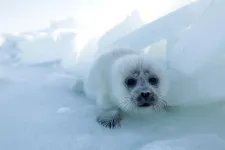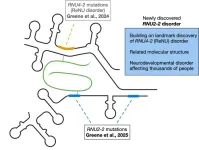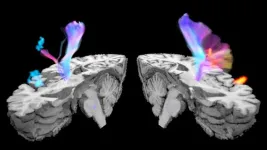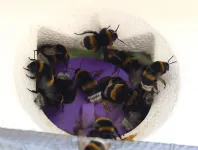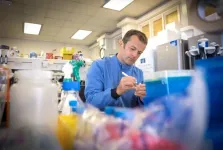(Press-News.org) UNDER EMBARGO UNTIL THURSDAY 10 APRIL, 10AM LONDON TIME, 5AM EASTERN TIME.
Urgent action is needed to protect endangered species, human health and industry from the impacts of the Caspian Sea shrinking, research led by the University of Leeds has found.
Water levels in the Caspian Sea – the world’s largest landlocked water body – are getting lower, as hotter temperatures cause more water to evaporate than is flowing in. Even if global warming is limited to below 2°C, it is likely that the level of the Caspian Sea will decline by 5 to 10 m, but if temperatures rise further, water levels could drop by as much as 21 m by 2100.
Researchers led by Leeds have mapped the potential risks this poses to the region’s biodiversity and human infrastructure, in a paper published today (Thursday 10 April) in Communications Earth & Environment.
The findings show that an area of 112,000 km² – which is larger than the size of Iceland – is likely to dry up, even in an optimistic scenario for global warming with a 10 m decline. Since many of the most ecologically and economically important areas are located in shallow water, this could have significant consequences for biodiversity and the sustainability of the region’s human population.
The Caspian Sea is home to the endangered Caspian seal and six species of sturgeon, as well as hundreds of species of fish and invertebrates found nowhere else. According to the research, the declining water levels will leave Caspian seals with significantly reduced breeding habitat, restrict access to spawning rivers for sturgeons, and lead to the loss of coastal lagoons and reed beds important for the spawning of other fish species and migrating birds.
More than 15 million people live around the Caspian coast, in Azerbaijan, Iran, Kazakhstan, Russia and Turkmenistan. The bordering nations rely on the water body for fishing, shipping and trade, and the sea is important for regulating climate in Central Asia.
In the northern Caspian, the findings show that some settlements, ports and industrial facilities could end up being stranded tens or even hundreds of kilometres from new shorelines. The exposed dry seabed is likely to release dust containing industrial contaminants and salt, posing serious threats to human health, as previously occurred with the drying of the Aral Sea.
The researchers say policymakers and conservationists need to take a dynamic approach to biodiversity protection, rather than relying on traditional protected areas with fixed boundaries, since these may quickly become obsolete due to the rapidly changing water levels.
Dr Simon Goodman from the School of Biology at the University of Leeds, who supervised the research, said: “Some Caspian Sea level decline appears unavoidable, even with action to reduce global greenhouse gas emissions. However, with the anticipated effects unfolding over a few decades, it should be possible to find ways to protect biodiversity while safeguarding human interests and wellbeing. That might sound like a long timescale, but, given the immense political, legislative and logistical challenges involved, it is advisable to start action as soon as possible to give the best chance of success.”
Biodiversity
Currently the Caspian Sea extends approximately 1150 km by 450 km, with a total area of 387,000 km².
With a 10 m decline, four out of 10 ecosystem types unique to the Caspian Sea would be expected to disappear completely, and the coverage of existing marine protected zones (areas earmarked for conservation) would be reduced by up to 94%.
Caspian seals give birth to their white-coated pups between mid-January and early March on ice in the northern Caspian Sea. However, the research shows a 5 m decline could reduce the area of this habitat by up to 81% - putting huge stressors on their already reduced population.
The Caspian seal was listed as Endangered by the International Union for the Conservation of Nature (IUCN) in 2008, and is included in the national Red Books of all five Caspian countries, signifying its recognition as a species at risk of extinction.
The decline will also make all current and historical haul-out sites – areas on land where seals rest – inaccessible. While receding water levels may create some new islands, further research is needed to assess their suitability for seals.
Sturgeons are an ancient family of large fish, and critically endangered due to overfishing for their meat and caviar (fish eggs or roe). The fish usually inhabit shallower parts of the sea in summer and autumn, but these areas are facing a potential reduction of 25% to 45% due to the fall in water levels, which may stop them accessing their few remaining spawning sites in rivers that flow into the Sea.
The Caspian Sea is also a globally important habitat for birds migrating between Europe, Asia and Africa. Migratory birds rely on coastal lagoons and reed beds for resting, shelter and food during their migrations, but such habitats are vulnerable to loss as waters recede.
Biodiversity in the Caspian Sea is already threatened by over-fishing, introduction of invasive species and pollution. Although work has been done to protect areas important for biodiversity, the paper predicts that overall coverage of existing Caspian marine protected areas disappear almost entirely for all countries except Kazakhstan, which would retain about 5% of current coverage.
Rebecca Court, PhD researcher in the School of Earth and Environment at Leeds, worked on the research as part of her Masters degree in the School of Biology. She said: “We hope this research will help to raise awareness of the trajectory and potential impacts of the falling sea level. The mapping should better equip policymakers and conservationists to plan for and address the numerous issues in advance.”
Industry and society
The findings also predict a concerning trajectory for industry, with critical ports in all bordering countries being impacted. Baku (Azerbaijan), Anzali (Iran), and Aktau (Kazakhstan) are expected to experience increases in distance to shore of 1 km or more, while Turkmenbashi (Turkmenistan), and Lagan (Russia; planned future site), could see increases of 16 km and 115 km respectively, according to the paper.
The Volga is the only river connecting the Caspian to the outside maritime world, and this vital trade route could be critically compromised by declines of just 5 m.
The Kashagan (Kazakhstan) and Filanovsky (Russia) oil fields in the northern Caspian are two of the region’s most important hydrocarbon production sites. Production currently occurs at offshore installations, with ship-based logistics, but these will become landlocked if Caspian Sea levels decline by 5 to 15 m.
Coastal communities in the north are likely to be hit hard as income from fishing disappears, and harsh climatic conditions make other economic activity like agriculture more difficult, potentially threatening social stability.
Some cities around the Caspian use desalination (removing salt and minerals from saltwater) for fresh water supplies, and water level declines are already impacting desalination operations at Aktau in Kazakhstan.
Loss of water from the Caspian could also affect the regional climate, leading to reduced rainfall and drier conditions across central Asia with indirect impacts on agriculture.
The energy resources of the Caspian Sea make it important geopolitically, so social, economic and environmental instability due to climate change could have worldwide repercussions.
Recommendations
Going forward, a balance needs to be struck between protecting biodiversity and human prosperity and wellbeing. The researchers’ recommendations include:
Investing to enhance regional capacity for biodiversity monitoring, conservation planning and sustainable development
Supporting coastal communities to diversify economically and develop resilient infrastructure
Developing legislation that enables the creation of protected areas with flexible borders
Taking a pre-emptive planning approach to avoid conflicts between biodiversity protection and efforts to adapt human infrastructure
Tracking rapidly changing ecosystems and implementing species translocations and ecosystem restoration where needed
Reducing greenhouse gas emissions at a global scale.
The researchers stress that urgent action is needed, with coordinated regional planning and global collaboration, to mitigate the projected impacts.
Dr Elchin Mamedov from the Ministry of Ecology and Natural Resources, Azerbaijan, said: "This is an important study because it highlights the risks posed by climate change for Caspian region biodiversity and local communities and the need to enhance regional and international cooperation to help manage the impacts."
The international collaboration involved researchers from Technische Universität Braunschweig (Germany), Technische Universität Berlin (Germany), Kaspika Caspian Seals Conservation Agency (Russia), Institute of Hydrobiology & Ecology (Kazakhstan), Museum of Natural History (Azerbaijan), Central Asian Institute of Ecological Research (Kazakhstan), Fisheries and Aquaculture Research Centre (Azerbaijan), Ramsar Regional Initiative of Central Asia (Turkmenistan), University of Bremen (Germany) and Justus Liebig University Giessen (Germany).
END
Caspian Sea decline threatens endangered seals, coastal communities and industry
2025-04-10
ELSE PRESS RELEASES FROM THIS DATE:
Landmark study identifies new genetic cause of neurodevelopmental disorders, bringing long-awaited answers to families
2025-04-10
New York, NY [April 10, 2025]—A seminal study from researchers at the Icahn School of Medicine at Mount Sinai and their collaborators in the United Kingdom, Belgium, Spain, the Netherlands, and Iceland has uncovered a new genetic cause of neurodevelopmental disorders (NDDs). The discovery offers both closure and hope to potentially thousands of families worldwide who have long been searching for answers.
The study, published in the April 10 online issue of Nature Genetics [DOI: 10.1038/s41588-025-02159-5], reveals that mutations in a small, previously overlooked non-coding gene called RNU2-2 are responsible for relatively common NDD. Non-coding genes ...
Scientists create “metal detector” to hunt down tumors
2025-04-10
Researchers have created a “metal detector” algorithm called PRRDetect to hunt down vulnerable tumours, in a development that could one day revolutionise the treatment of cancer.
In a paper published today (Thursday 10th April) in Nature Genetics, scientists funded by Cancer Research UK and the National Institute for Health and Care Research (NIHR) analysed the full DNA sequence of 4,775 tumours from seven types of cancer. Based at the University of Cambridge and NIHR Cambridge Biomedical Research Centre, they used that data from Genomics England’s 100,000 Genomes ...
New USC study identifies key brain networks behind post-stroke urinary incontinence
2025-04-10
A new USC-led study using functional magnetic resonance imaging (fMRI) reveals the neural mechanisms that contribute to urinary incontinence, a common condition affecting stroke survivors that has a significant impact on their quality of life.
The research, just published in Stroke, was conducted by a multidisciplinary team of urologists, neurosurgeons, and imaging experts from the Keck School of Medicine of USC, Keck Medicine of USC, the Rancho Los Amigos National Rehabilitation Center, and the Shirley Ryan Ability Lab. The team discovered significant differences in brain activity during voluntary versus involuntary bladder contractions, presenting potential pathways for targeted therapies.
Urinary ...
Hidden potential in multiple disabilities
2025-04-10
Using eye-tracking — a technique for recording and analysing eye movements — a team from the University of Geneva (UNIGE) has shown that individuals with multiple disabilities can improve their social and emotional skills. Although these patients are often considered ‘‘untestable’’, nine young people have undergone personalised training over a period of one year, with promising results in terms of their ability to socialise. This work opens the way to new methods of assessment and support. It is published in Acta Psychologica.
Multiple disabilities involve a combination of severe intellectual and motor impairments, resulting in profound dependence. ...
How to protect bumblebee colonies safe from killer moths? Keep honeybee hives away from them
2025-04-10
Since the pandemic, we are very aware of the power of social distancing to protect against infectious disease. But can social distancing be effective if the infectious agent isn’t a virus or bacterium, but an insect powered by a brain and wings, and with the instinct to seek out new hosts?
Now, a study published to Frontiers in Bee Science has shown that physical distance does play a leading role in protecting bumblebees against a flying insect parasite, the bumblebee wax moth Aphomia sociella. The source of the potentially lethal infection was another species, namely nearby hives of domestic honeybees.
“Here we show that infestation with bumblebee wax moths is much greater ...
Rolling particles make suspensions more fluid
2025-04-10
Lacquers, paint, concrete—and even ketchup or orange juice: Suspensions are widespread in industry and everyday life. By a suspension, materials scientists mean a liquid in which tiny, insoluble solid particles are evenly distributed. If the concentration of particles in such a mixture is very high, phenomena can be observed that contradict our everyday understanding of a liquid. For example, these so-called non-Newtonian fluids suddenly become more viscous when a strong force acts upon them. For a brief moment, the liquid behaves like a solid.
This sudden thickening is caused by the particles present ...
Research fine tunes tools used to search for genetic causes of asthma
2025-04-10
Genome wide association studies (GWAS) have identified hundreds of genome regions containing thousands of genetic variants associated with asthma, but it’s still not clear which variants have an actual causal link to the disease. This “variant-to-function” gap is one of the biggest challenges to the usefulness of these genomic studies and has motivated researchers to develop new tools to make sense of GWAS results.
A new study by researchers from the University of Chicago combines genetic data and improved computational tools to look more closely ...
Meditation and critical thinking are the ‘key to meaningful AI use’
2025-04-10
People should learn to meditate and hone their critical thinking skills as AI becomes more integrated into daily lives, an expert suggests.
Digital strategy expert Giulio Toscani has spoken with 150 AI experts across 50 countries to understand the challenges and opportunities around human interactions with artificial intelligence.
He argues in his new book, Augmented: prAIority to Enhance Human Judgment through Data and AI, that as humans operate largely unconsciously by design, they are inclined toward immediacy and instant rewards, often overlooking potential ...
Studies shows new class of antibiotic is effective in tackling MRSA
2025-04-10
The development of new antibiotics to treat superbugs and other bacterial infections is a global priority, with the rate of infections that cannot be treated with current antibiotics rising and presenting one of the biggest threats to human health.
In line with that, new research has shown a daily dose of epidermicin NI01 – an antibiotic compound developed by University of Plymouth spinout company Amprologix – is as effective at removing Methicillin-resistant Staphylococcus aureus (MRSA) as the current standard of care.
The results were achieved through a robust skin MRSA infection model, and those behind the research say it justifies ...
Certain nasal bacteria may boost the risk for COVID-19 infection, study finds
2025-04-10
WASHINGTON (April 9, 2025) — A new study from researchers at the George Washington University has found that certain bacteria living in the nose may influence how likely someone is to get a COVID-19 infection. Published in EBioMedicine, the research reveals that certain types of nasal bacteria can affect the levels of key proteins the virus needs to enter human cells, offering new insight into why some people are more vulnerable to COVID-19 than others.
“We’ve known that the virus SARS-CoV-2 enters the body through the respiratory tract, with the nose being a key entry point. What’s new—and surprising—is that bacteria in our noses ...
